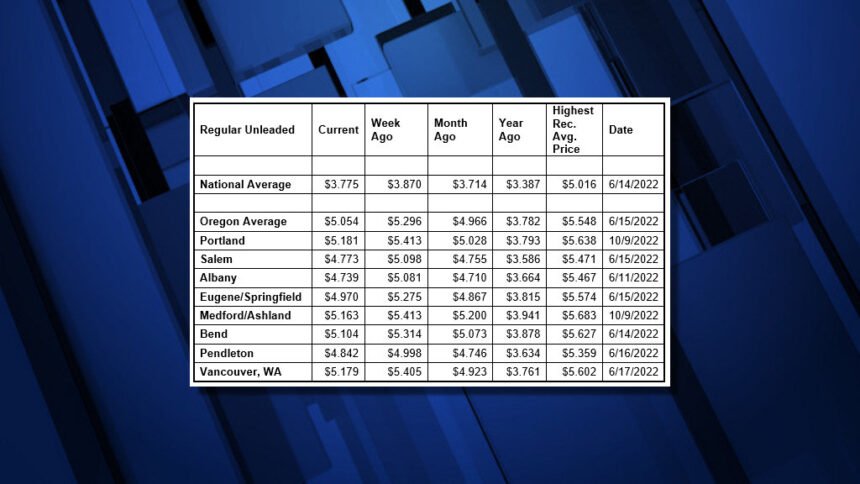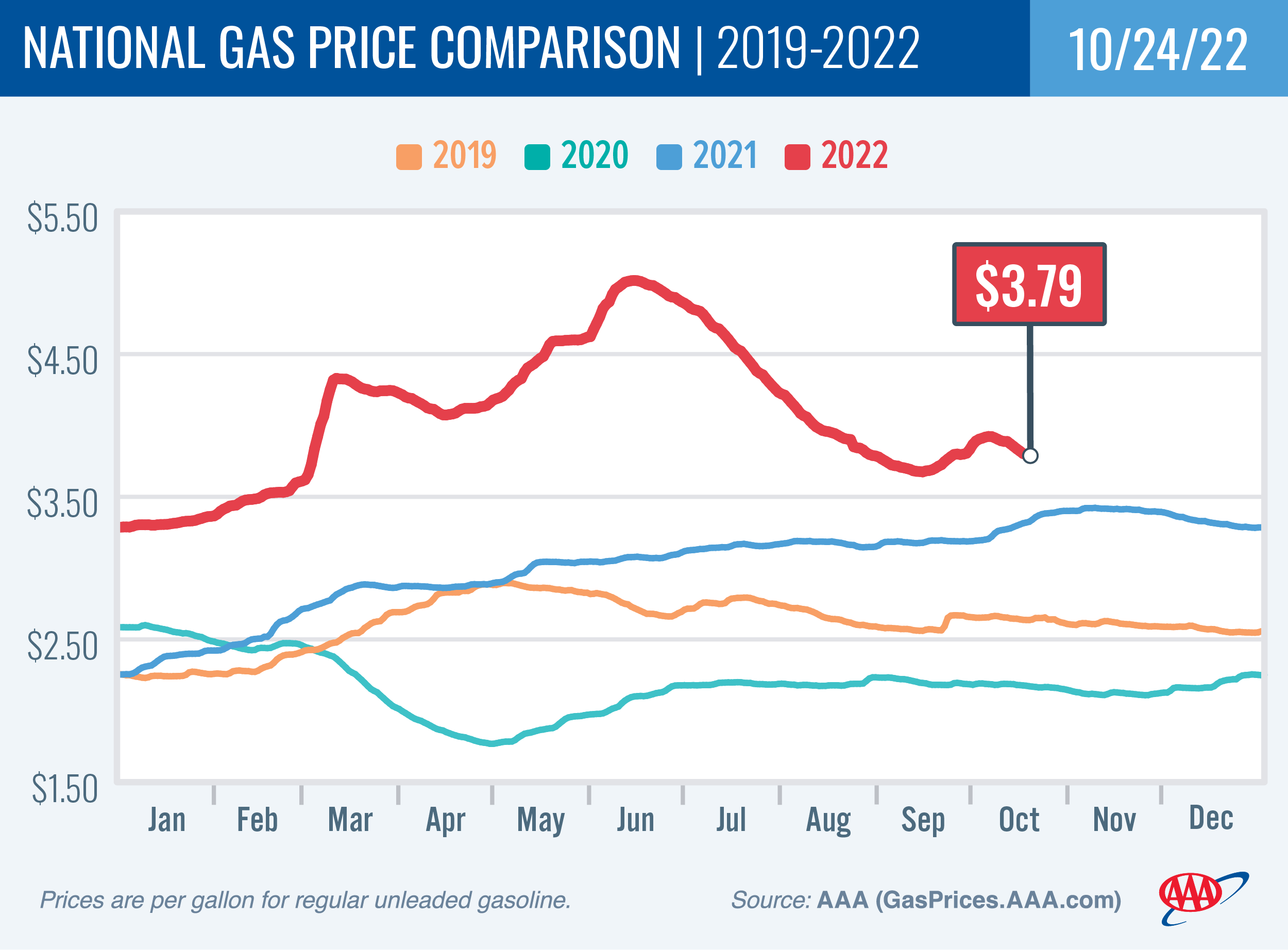AAA reports 24-cent drop in Oregon gas prices in past week; West Coast paces U.S.


(Update: AAA Oregon/Idaho figures
PORTLAND, Ore. (KTVZ) – Pump prices have been falling every day for more than two weeks, with Oregon and other West Coast states seeing the biggest weekly drops in the nation, AAA Oregon/Idaho said Tuesday.
Lower crude oil prices and fewer drivers than usual fueling up are helping to drive the decreases. For the week, the national average for regular drops 10 cents to $3.78 a gallon. The Oregon average tumbles 24 cents to $5.05. This is the third-largest weekly drop for a state in the nation, only behind Alaska (-36 cents) and California (-29 cents).
The Oregon average came within a penny of reaching a new record high this month when it got to $5.54 a gallon on October 9. It has decreased every day since then. The national average climbed to $3.92 on October 11 and has fallen every day since then. Refinery outages in the West Coast region and the resulting drop in supplies helped fuel the dramatic pump price increases in this area.
Both the national and Oregon averages hit record highs in mid-June, then declined for 14 consecutive weeks before rising again starting in late September. The national average reached its record high of $5.016 on June 14 while the Oregon average reached its record high of $5.548 on June 15.
“Crude oil prices have been tempered by fears of a global recession, along with the Biden Administration’s plan to continue tapping the Strategic Petroleum Reserve into December. This should help take pressure off pump prices, bringing some relief to drivers and their wallets,” says Marie Dodds, public affairs director for AAA Oregon/Idaho.
Crude oil prices have stayed below $90 per barrel since October 10. Crude reached a recent high of $122.11 per barrel on June 8, and ranged from about $94 to $110 per barrel in July. In August, crude prices ranged between about $86 and $97. In September, crude prices ranged between about $76 and $88 per barrel. So far in October, crude has ranged between $82 and $92 per barrel.
Crude prices rose dramatically leading up to and in the first few months of Russia’s invasion of Ukraine. Russia is one of the world’s top oil producers and its involvement in a war causes market volatility, and sanctions imposed on Russia by the U.S. and other western nations resulted in tighter global oil supplies. Oil supplies were already tight around the world as demand for oil increased as pandemic restrictions eased. A year ago, crude was around $73 per barrel compared to $85 today.
Crude oil is the main ingredient in gasoline and diesel, so pump prices are impacted by crude prices on the global markets. On average, about 53% of what we pay for in a gallon of gasoline is for the price of crude oil, 12% is refining, 21% distribution and marketing, and 15% are taxes, according to the U.S. Energy Information Administration.
Demand for gasoline in the U.S. increased slightly from 8.28 million b/d to 8.68 million b/d for the week ending October 14. This is about 1 million b/d less than a year ago. Total domestic gasoline stocks decreased marginally from 209.5 million bbl to 209.4 million bbl. If demand remains low and oil prices don’t spike, pump prices will likely keep falling.
Quick stats
All 50 states and the District of Columbia have lower prices week-over-week. West Coast states have the largest weekly drops: Alaska (-36 cents), California (-29 cents), Oregon (-24), Washington (-23 cents) and Nevada (-19).
California ($5.71) has the most expensive gas in the country for the seventh week in a row, but the state average has dropped below $6 a gallon. Five states, including Oregon, have averages at or above $5 a gallon. This week 12 states have averages at or above $4, and 38 states and the District of Columbia have averages in the $3-range.
The cheapest gas in the nation is in Georgia ($3.19) and Texas ($3.20). For the 94th week in a row, no state has an average below $2 a gallon.
The difference between the most expensive and least expensive states is $2.52 which is stark.
Oregon is one of 32 states and the District of Columbia with higher prices now than a month ago. The national average is six cents more and the Oregon average is nine cents more than a month ago. Oregon has the 19th-largest monthly increase in the nation. Delaware (+27 cents) has the largest month-over-month jump. Colorado (-15 cents) has the largest monthly drop.
Oregon is one of 48 states and the District of Columbia with higher prices now than a year ago. The national average is 39 cents more and the Oregon average is $1.27 more than a year ago. This is the second-largest yearly increase in the nation. Alaska (+$1.32) has the biggest yearly increase. Florida (+3 cents) has the smallest year-over-year increase. Georgia (-5 cents) and Connecticut (-3 cents) are the only two states with year-over-year declines.
West Coast
The West Coast region continues to have the most expensive pump prices in the nation with all seven states in the top 10. This is typical for the West Coast as this region tends to consistently have fairly tight supplies, consuming about as much gasoline as is produced. In addition, this region is located relatively far from parts of the country where oil drilling, production and refining occurs, so transportation costs are higher. And environmental programs in this region add to the cost of production, storage and distribution.
Refinery issues in California in September and earlier this month exacerbated the situation, creating extremely tight supplies and causing pump prices in this region to skyrocket.
| Rank | Region | Price on 10/25/22 | ||
| 1 | California | $5.71 | ||
| 2 | Hawaii | $5.21 | ||
| 3 | Oregon | $5.05 | ||
| 4 | Alaska | $5.05 | ||
| 5 | Nevada | $5.04 | ||
| 6 | Washington | $4.99 | ||
| 7 | Idaho | $4.36 | ||
| 8 | Arizona | $4.35 | ||
| 9 | Illinois | $4.21 | ||
| 10 | Utah | $4.19 |
As mentioned above, California is the most expensive state for the seventh consecutive week with Hawaii, Oregon, Alaska, Nevada, and Washington rounding out the top six. Arizona is eighth. Oregon is third most expensive for the fifth consecutive week.
Five of the seven states in the region are seeing the largest weekly declines in the country: Alaska (-36 cents), California (-29 cents), Oregon (-24), Washington (-23 cents) and Nevada (-19). Arizona (-10 cents) has the 12th-largest weekly drop. Hawaii (-2 cents) as the 43rd-largest week-over-week decline.
The refinery utilization rate on the West Coast rose from 80.1% to 82.3% for the week ending October 14. The rate has ranged between about 76% and 90% in the last year.
According to EIA’s latest weekly report, total gas stocks in the region increased from 24.80 million bbl. to 25.89 million bbl.
Oil market dynamics
Although crude prices increased after the EIA reported that total domestic commercial crude inventories dropped by 1.7 million bbl to 437.4 million bbl last week, the price of oil had declined earlier in the week due to ongoing market concerns about crude demand as recession fears increased. If the market remains concerned about the rate of economic growth this week, crude prices could decline.
At the close of Friday’s formal trading session, WTI increased by 54 cents to settle at $85.05. At the close of Monday’s formal trading session, WTI slipped 47 cents to close at $84.58. Today crude is trading around $85, compared to $83 a week ago. Crude prices are about $1 more than a year ago.
Drivers can find current gas prices along their route with the free AAA Mobile app for iPhone, iPad and Android. The app can also be used to map a route, find discounts, book a hotel and access AAA roadside assistance. Learn more at AAA.com/mobile.

Diesel
For the week, the national average edges up 2 cents to $5.32 a gallon. The record high is $5.816 set on June 19. Oregon’s average falls six cents to $5.67. The record high is $6.47 set on July 3. A year ago the national average for diesel was $3.61 and the Oregon average was $3.77.
===
CHICAGO (KTVZ) -- Average gasoline prices in Oregon have fallen 25.1 cents per gallon in the last week, averaging $5.05/gallon Monday, according to GasBuddy's survey of 1,307 stations in Oregon.
But it said gas prices in Oregon are still 22.4 cents per gallon higher than a month ago and stand $1.29/g higher than a year ago. The national average price of diesel has risen 4.0 cents in the last week and stands at $5.30 per gallon.
According to GasBuddy price reports, the cheapest station in Oregon was priced at $3.95/g Sunday while the most expensive was $5.79/g, a difference of $1.84/g.
The national average price of gasoline has fallen 9.3 cents per gallon in the last week, averaging $3.77/g Monday. The national average is up 10.2 cents per gallon from a month ago and stands 41.2 cents per gallon higher than a year ago, according to GasBuddy data compiled from more than 11 million weekly price reports covering over 150,000 gas stations across the country.
Historical gasoline prices in Oregon and the national average going back ten years:
October 24, 2021: $3.76/g (U.S. Average: $3.36/g)
October 24, 2020: $2.48/g (U.S. Average: $2.15/g)
October 24, 2019: $3.33/g (U.S. Average: $2.61/g)
October 24, 2018: $3.34/g (U.S. Average: $2.84/g)
October 24, 2017: $2.71/g (U.S. Average: $2.45/g)
October 24, 2016: $2.54/g (U.S. Average: $2.22/g)
October 24, 2015: $2.32/g (U.S. Average: $2.20/g)
October 24, 2014: $3.26/g (U.S. Average: $3.06/g)
October 24, 2013: $3.46/g (U.S. Average: $3.31/g)
October 24, 2012: $3.94/g (U.S. Average: $3.62/g)
Oregon areas and their current gas prices:
Eugene- $4.99/g, down 35.3 cents per gallon from last week's $5.34/g.
Salem- $4.76/g, down 37.4 cents per gallon from last week's $5.14/g.
Portland- $5.20/g, down 21.4 cents per gallon from last week's $5.42/g.
"Average gas prices have declined for the second straight week with significant declines in the West and Great Lakes having an oversized effect on the drop in the national average," said Patrick De Haan, head of petroleum analysis at GasBuddy.
"With oil prices struggling a bit after reaching $93 after OPEC+'s decision to cut production, many regions could see falling gas prices again this week as demand continues to decline seasonally, especially if more data points to a significant economic slowdown.
"While gasoline prices have seen a large drop, diesel prices have been somewhat mixed, with prices heading higher in the Northeast as inventories drop to extremely tight levels ahead of the heating oil season. Motorists are reminded that the decline in gasoline prices is seasonal and should continue into the fall, and is unrelated to the coming election. Seasonality is king in driving prices, not the desires or hopes of politicians."
GasBuddy is the authoritative voice for gas prices and the only source for station-level data. GasBuddy's survey updates 288 times every day from the most diverse list of sources covering nearly 150,000 stations nationwide, the most comprehensive and up-to-date in the country. GasBuddy data is accessible at http://prices.GasBuddy.com.
GasBuddy also fuels KTVZ.COM's Pump Patrol, where you can find the cheapest gas prices on the High Desert.